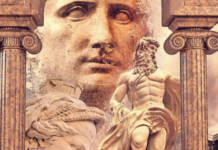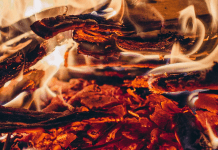
While searching for my roots and the beliefs of my ancestors, those who lived before Islam, I came across an interesting triad. Wicca taught me that the Goddess has three faces to represent womanhood’s three stages: Maiden, Mother and Crone. Although I’m no longer Wiccan, it was a nice surprise to discover an Arabic pre-Islamic triad with this same concept.
Related: How an Arab witch honours and contacts his ancestors by Bader Saab
The Three Daughters of Allah, Al-Uzza, Al-lat, and Manat are respectively the Maiden, Mother and Crone of the pre-Islamic world. After years of invoking the Greek goddess Hekate, I obviously gravitated towards Manat, the Old One, the Crone, the goddess of time, fate, and death, but who exactly is she?
It is said in pre-Islamic belief that Allah (“God” in Arabic) left his active role in the Universe after creating it, becoming a passive spectator from a distant, calm corner, in order to rest. His three daughters became intermediaries between humankind and Allah, who would only act in desperate times. Manat, sometimes spelled as Manah, is believed to be the first one Allah created, and so the oldest of his daughters. The Kitāb al-ʾAṣnām, or The Book of Idols, by Hisham Ibn Al-Kalbi, explains:
The most ancient of all these idols was Manāt. The Arabs used to name [their children] ‘Abd-Manāt and Zayd-Manāt. Manāt was erected on the seashore in the vicinity of al-Mushallal in Qudayd, between Medina and Mecca. All the Arabs used to venerate her and sacrifice before her. The Aws and the Khazraj, as well as the inhabitants of Medina and Mecca and their vicinities, used to venerate Manāt, sacrifice before her, and bring unto her their offerings…
The Aws and the Khazraj, as well as those Arabs among the people of Yathrib and other places who took to their way of life, were wont to go on pilgrimage and observe the vigil at all the appointed places, but not shave their heads. At the end of the pilgrimage, however, when they were about to return home, they would set out to the place where Manāt stood, shave their heads, and stay there a while. They did not consider their pilgrimage completed until they visited Manāt.
She is sometimes described as the mother, and other times the consort, of Hubal, a warrior god believed to control acts of divination. Quzah, the Meccan god of storms, thunder, and the clouds, has also been named as her consort. Her idol was a large outcrop of black marble. Also, Manat was believed to change the fate of those who displeased her for the worse, and so an oath sworn by Her was considered the most serious and sincere. Since she is a goddess of death, Manat was called upon in Nabataean rituals, along with Qaysha, Taraha and Dhu-Shara, in order to protect tombs and curse those who disturbed them.
I have a prayer I say for her, which came naturally to me, and which I use when I feel the need to. Arabic changes a little depending on the country, so I prefer to translate the prayer to English and encourage you to pronounce it as you prefer. As long as our heart remains honest and we know who we’re talking to, Manat will listen to us.
Ia Manat,
You that kiss the Moon, (optional phrase)
You that know what will happen to us,
You that put eyes in this house of ours,
You that kissed these hands,
Kiss one and kiss two.
Salam Aleykun, Ia Manat, Aleykun el Salam.
Another prayer was shared by ‘Amr-Athtar Yunajjam, which was used to venerate the three sisters. I have used it a few times, and like how it sounds and feels:
Wa’l-Lāt-a wa’l Uzzā, wa Manāt-a al-thalithāta al-‘ukhrā, Tilk al-gharāniq al-‘ulā, wa inna shafā’ata-hunna la-turtajā.
In English:
By al-Lāt and al-‘Uzzā, and Manāt, the third goddess, the other; Verily they are the most exalted cranes, and their intercession is to be hoped for.
My most recent practice is to write her name in Arabic as a form of meditation: مناة. I do it just like that, without any protocol or ceremony, trying to memorize and understand what I’m writing, trying to feel the power of the letters as they appear. I would suggest you do the same, and of course I encourage you to share the results!
A vision from Manat
Once in a trance, I had a vision of my grandmother’s house, which is in my hometown. There was no one in there except for me and two figures. The first one was a green man with antlers that I strongly believe was the Celtic god Cernunnos. The other one was a woman, small, dressed in black, fine clothes and a white veil around her head not covering her face. You guessed it, it was Manat.
I still remember the compassion, love, and understanding in her face, especially her eyes, how smooth and clean her clothes were, and how warm her hands felt when she took mine. I won’t say I cried, I honestly cannot remember more than that, but when I came back I still felt her presence around me. She accepted me for who I was, am and would be, for she already knew.
The only problem I come up with over and over again is the lack of trustworthy information on Manat, but I prefer to look at this as my chance to be part of her myths and (who knows?) reconstruction. If we revel at the large amount of data about a deity, why not do the same when there is hardly anything known for sure?
I’m still working on my connection with Manat. She is a goddess I keep learning about, a deity I cannot stop inviting to my rituals in general. Her energy is so feral, dense, and mysterious that is almost addictive. You develop a hunger, a liking for that unknown vibration, and if you’re as curious as I am, you will want to understand it. But to truly understand this long-forgotten goddess of time, fate and death? Good luck with that!
Image credit: Thalia Took








